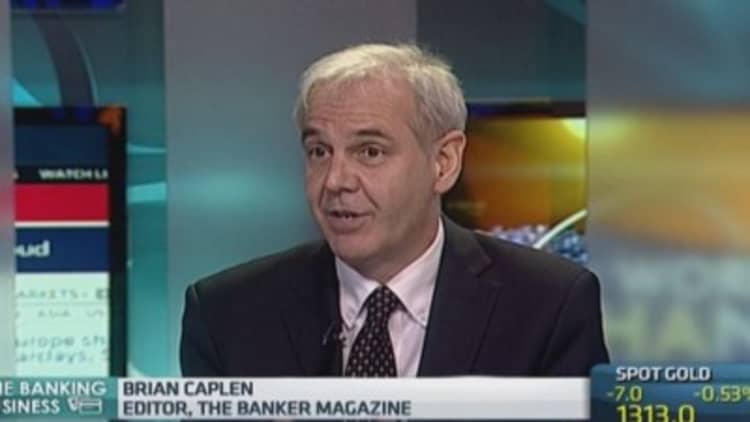Shanghai is leading a race to host the headquarters of a new "Brics" development bank that will challenge for the first time the US postwar dominance of multilateral lending institutions, people familiar with the matter in Brasília and Washington said.
The bank, to be controlled by Brazil, Russia, India, China and South Africa, is expected to start with capital of $50 billion and to be officially launched by the Brics heads of state at a summit in Brazil on July 15.
The Brics, an acronym invented by former Goldman Sachs economist Jim O'Neill to describe the world's largest fast-growing emerging markets, are also expected to set up a joint $100 billion emergency swap fund for financial crises.
Read MoreNever heard of the Ex-Im Bank? Here's why you will
"From this next summit, the Brics will be identified with a bank and with a contingent reserves arrangement which are in the process of being approved," said José Alfredo Graça Lima of Brazil's external relations ministry.
The new bank, which will be the first bricks-and-mortar institution to be set up by the Brics economies, will initially be too small to rival the World Bank or the International Monetary Fund in terms of size and importance.
But it will serve as a reminder to US policy makers of the need to reform these institutions to better reflect the shift in the global economy towards the developing world.
Read MoreChina's riskyborrowers really getting a better deal?
The establishment of the Brics bank comes as China leads the charge for a separate multilateral institution in Asia to rival the Asian Development Bank, which Beijing fears is, along with the World Bank, overly influenced by the US and its allies. Last month it proposed doubling the size of registered capital for the bank, which would be called the Asian Infrastructure Investment Bank, to $100 billion, compared with the ADB's $165 billion, the FT reported last week.
Proposals to increase the influence of emerging nations in the International Monetary Fund have been stuck in Congress since they were agreed in 2010.
"Congress is not ratifying [the changes] and that has caused a certain amount of disquiet and unease among the Brics countries," said Brazil's Mr Graça Lima.
More from the Financial Times:
China to try GSK couple 'in secret'
Wall St struggles ahead of payrolls data
Xi'sSeoul visit leaves Pyongyang in the cold
"This arrangement [the Brics bank and reserve fund] is not a response to that [but] it is an indication that it is possible among the Brics to create mechanisms to realise certain objectives."
Under the plan, four of the Brics – China, Russia, India and South Africa – are suggesting cities to host the headquarters of the new institution. Brazil is not nominating any city for the role.
The issue is expected to be decided at the leaders' summit but Shanghai is seen by analysts as the favorite.
Each of the Brics will contribute an initial $10 billion to the new bank, whose name has yet to be decided, of which part will be paid in immediately and the rest will be callable capital – available only if needed to meet the bank's obligations. The total authorized capital will be $100 billion. The World Bank had capital as of June last year of $223 billion, most of it callable.
Read MoreBulgaria bank fail flags region's 'Achilles heel'
Membership by other countries will be considered at a later stage but the Brics will remain in control of the majority of the shares.
The leadership of the bank is likely to be rotated every five years with the first president of the institution to be decided by the heads of state in July.
In the case of the reserve fund, known as the contingent reserves arrangement, China will contribute $41 billion, Brazil, Russia and India $18 billion and South Africa, $5 billion.

The arrangement governing the reserve fund will be similar to the Chiang Mai Initiative, a currency swap deal between Asian countries.
The bank meant different things to each of the Brics, said Oliver Stuenkel, assistant professor of international relations at the Getulio Vargas Foundation in São Paulo.
Read MoreInvesting in China: A Catch-22?
For India and Brazil, it could become a promising source of funds for their huge infrastructure needs while for China, it is a way of hedging bets while the US-dominated Bretton Woods institutions remain in deadlock.
For India, it would be a convenient way of channelling politically sensitive funding from geopolitical rival China into the country while for China it could become a way of broadening the market for its currency, the renminbi.
"This is a considerable group of countries from around the world that have come together to create something without US or European involvement, this is significant," said Mr Stuenkel.
He said he did not believe it was part of a strategic effort by the Brics to undermine the existing world order and it remained too small at present to have that effect but it was nonetheless important.
Read MoreEurope banks hampered by '1970s' tech: Deloitte
"I don't think it is part of a long-term plan but it shouldn't be underestimated," said Mr Stuenkel.
He said the Brics summit in July would also give Brazil a chance to show regional leadership. Brasília is inviting other Latin American leaders to come to meet the Brics heads of state.
The bank also represented a slightly more activist China on the international front than has been traditional, said Marcos Troyjo, a professor at Columbia University and co-director of the BricLab-Centre on Global Economic Governance.
"The international jungle will be all the more interesting with this new animal," he said.

